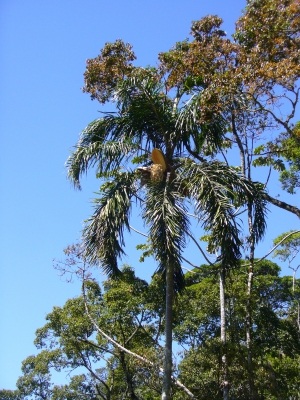Syagrus pseudococos
(Raddi) Glassman
Arecaceae
Barbosa pseudococos (Raddi) Becc.
Calappa mikaniana (Mart.) Kuntze
Cocos mikaniana Mart.
Langsdorffia pseudococos Raddi
Syagrus mikaniana (Mart.) Mart.
Common Name:

Flowering tree in Brazil
Photograph by: Scott Zona
Creative Commons Attribution 2.0

Flowering tree in Brazil
Photograph by: Scott Zona
Creative Commons Attribution 2.0

General Information
Syagrus pseudococos is a single-stemmed, evergreen palm growing from 10 - 15 metres tall. The unbranched stem can be up to 25cm in diameter; it is swollen at the base; and topped by a crown of 18 - 20 leaves that can each be up to 2.2 metres long[
768- Title
- Field Guide to the Palms of the Americas
- Publication
-
- Author
- Henderson A.; Galeano G.; Bernal R.
- Publisher
- Princeton University Press; Princeton, New Jersey.
- Year
- 1995
- ISBN
- 0-691-08537-4
- Description
- An excellent book, giving basic information on all the 550 species of palms native to the Americas that were known in 1995. Comprehensive information on the plants range and habitat, brief description, some uses and almost 250 photos.
].
The plant is sometimes harvested from the wild for local use as a source of food and medicine.
Endemic to the Atlantic forest of Brazil, this palm tree is found at sea level in the south but only in the mountains at elevations up to 900 metres in the north. Stands are found on good-quality soils and also rocky outcrops on steep slopes with less agricultural value. The plant is classified as 'Least Concern' in the IUCN Red List of Threatened Species(2011)[
338- Title
- IUCN Red List of Threatened Species
- Publication
-
- Author
-
- Website
- http://www.iucnredlist.org/
- Publisher
-
- Year
- 0
- ISBN
-
- Description
- A list of plants under threat and facing possible extinction, usually with brief details of the threats and information on habitat.
].
Known Hazards
None known
Botanical References
768- Title
- Field Guide to the Palms of the Americas
- Publication
-
- Author
- Henderson A.; Galeano G.; Bernal R.
- Publisher
- Princeton University Press; Princeton, New Jersey.
- Year
- 1995
- ISBN
- 0-691-08537-4
- Description
- An excellent book, giving basic information on all the 550 species of palms native to the Americas that were known in 1995. Comprehensive information on the plants range and habitat, brief description, some uses and almost 250 photos.
Range
S. America - eastern Brazil.
Habitat
Forested areas and pastures[
768- Title
- Field Guide to the Palms of the Americas
- Publication
-
- Author
- Henderson A.; Galeano G.; Bernal R.
- Publisher
- Princeton University Press; Princeton, New Jersey.
- Year
- 1995
- ISBN
- 0-691-08537-4
- Description
- An excellent book, giving basic information on all the 550 species of palms native to the Americas that were known in 1995. Comprehensive information on the plants range and habitat, brief description, some uses and almost 250 photos.
]. Found at elevations down to sea level in the south of its range, but only at higher elevations up to 900 metres where it is found nearer the Equator[
338- Title
- IUCN Red List of Threatened Species
- Publication
-
- Author
-
- Website
- http://www.iucnredlist.org/
- Publisher
-
- Year
- 0
- ISBN
-
- Description
- A list of plants under threat and facing possible extinction, usually with brief details of the threats and information on habitat.
].
Properties
| Conservation Status | Least Concern |
| Edibility Rating |      |
| Medicinal Rating |      |
| Habit | Evergreen Tree |
| Height | 12.00 m |
| Cultivation Status | Wild |
Cultivation Details
Not known
Edible Uses
Leaves - cooked[
]. A bitter flavour[
739- Title
- Medicinal Plants of Brazil
- Publication
-
- Author
- Mors W.B.; Rizzini C.T.; Pereira N.A.
- Publisher
- Reference Publications; Michigan.
- Year
- 2000
- ISBN
- 0-917256-42-5
- Description
- An extremely concise book, listing approximately 1,500 species and varieties of plants with their botanical name, common name in Brazil, regions in Brazil where the plant is found, a brief list of uses and any medically active compounds in the plant.
]. The apical bud, often known as a 'palm heart', is eaten as a vegetable[
]. Eating this bud leads to the death of the tree because it is unable to make side shoots[
K- Title
- Plants for a Future
- Author
- Ken Fern
- Description
- Notes from observations, tasting etc at Plants For A Future and on field trips.
].
Medicinal
The apical bud is used medicinally[
]. The bitter-tasting bud is soaked in water and then used in the treatment or prevention of indigestion[
739- Title
- Medicinal Plants of Brazil
- Publication
-
- Author
- Mors W.B.; Rizzini C.T.; Pereira N.A.
- Publisher
- Reference Publications; Michigan.
- Year
- 2000
- ISBN
- 0-917256-42-5
- Description
- An extremely concise book, listing approximately 1,500 species and varieties of plants with their botanical name, common name in Brazil, regions in Brazil where the plant is found, a brief list of uses and any medically active compounds in the plant.
].
Other Uses
None known
Propagation
Seed -
If you have any useful information about this plant, please leave a comment. Comments have to be approved before they are shown here.




 Useful Tropical Plants Database 2014 by
Ken Fern,
web interface by
Ajna Fern
with help from
Richard Morris.
Useful Tropical Plants Database 2014 by
Ken Fern,
web interface by
Ajna Fern
with help from
Richard Morris.